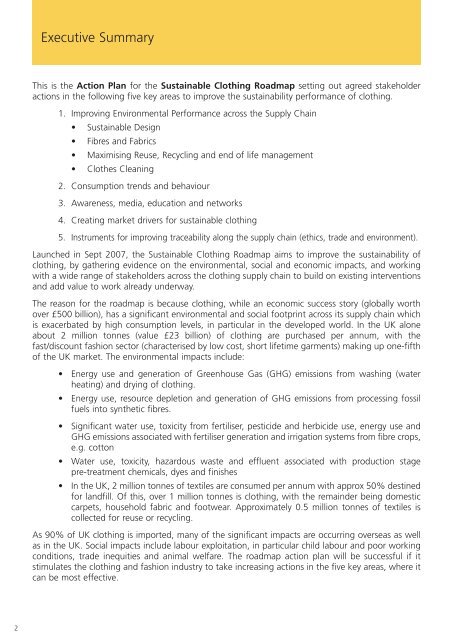SUSTAINABLE CLOTHING ACTION PLAN - Defra
SUSTAINABLE CLOTHING ACTION PLAN - Defra
SUSTAINABLE CLOTHING ACTION PLAN - Defra
You also want an ePaper? Increase the reach of your titles
YUMPU automatically turns print PDFs into web optimized ePapers that Google loves.
2<br />
Guidance Executive Summary<br />
for Indirect Bidders<br />
This is the Action Plan for the Sustainable Clothing Roadmap setting out agreed stakeholder<br />
actions in the following five key areas to improve the sustainability performance of clothing.<br />
1. Improving Environmental Performance across the Supply Chain<br />
• Sustainable Design<br />
• Fibres and Fabrics<br />
• Maximising Reuse, Recycling and end of life management<br />
• Clothes Cleaning<br />
2. Consumption trends and behaviour<br />
3. Awareness, media, education and networks<br />
4. Creating market drivers for sustainable clothing<br />
5. Instruments for improving traceability along the supply chain (ethics, trade and environment).<br />
Launched in Sept 2007, the Sustainable Clothing Roadmap aims to improve the sustainability of<br />
clothing, by gathering evidence on the environmental, social and economic impacts, and working<br />
with a wide range of stakeholders across the clothing supply chain to build on existing interventions<br />
and add value to work already underway.<br />
The reason for the roadmap is because clothing, while an economic success story (globally worth<br />
over £500 billion), has a significant environmental and social footprint across its supply chain which<br />
is exacerbated by high consumption levels, in particular in the developed world. In the UK alone<br />
about 2 million tonnes (value £23 billion) of clothing are purchased per annum, with the<br />
fast/discount fashion sector (characterised by low cost, short lifetime garments) making up one-fifth<br />
of the UK market. The environmental impacts include:<br />
• Energy use and generation of Greenhouse Gas (GHG) emissions from washing (water<br />
heating) and drying of clothing.<br />
• Energy use, resource depletion and generation of GHG emissions from processing fossil<br />
fuels into synthetic fibres.<br />
• Significant water use, toxicity from fertiliser, pesticide and herbicide use, energy use and<br />
GHG emissions associated with fertiliser generation and irrigation systems from fibre crops,<br />
e.g. cotton<br />
• Water use, toxicity, hazardous waste and effluent associated with production stage<br />
pre-treatment chemicals, dyes and finishes<br />
• In the UK, 2 million tonnes of textiles are consumed per annum with approx 50% destined<br />
for landfill. Of this, over 1 million tonnes is clothing, with the remainder being domestic<br />
carpets, household fabric and footwear. Approximately 0.5 million tonnes of textiles is<br />
collected for reuse or recycling.<br />
As 90% of UK clothing is imported, many of the significant impacts are occurring overseas as well<br />
as in the UK. Social impacts include labour exploitation, in particular child labour and poor working<br />
conditions, trade inequities and animal welfare. The roadmap action plan will be successful if it<br />
stimulates the clothing and fashion industry to take increasing actions in the five key areas, where it<br />
can be most effective.

















